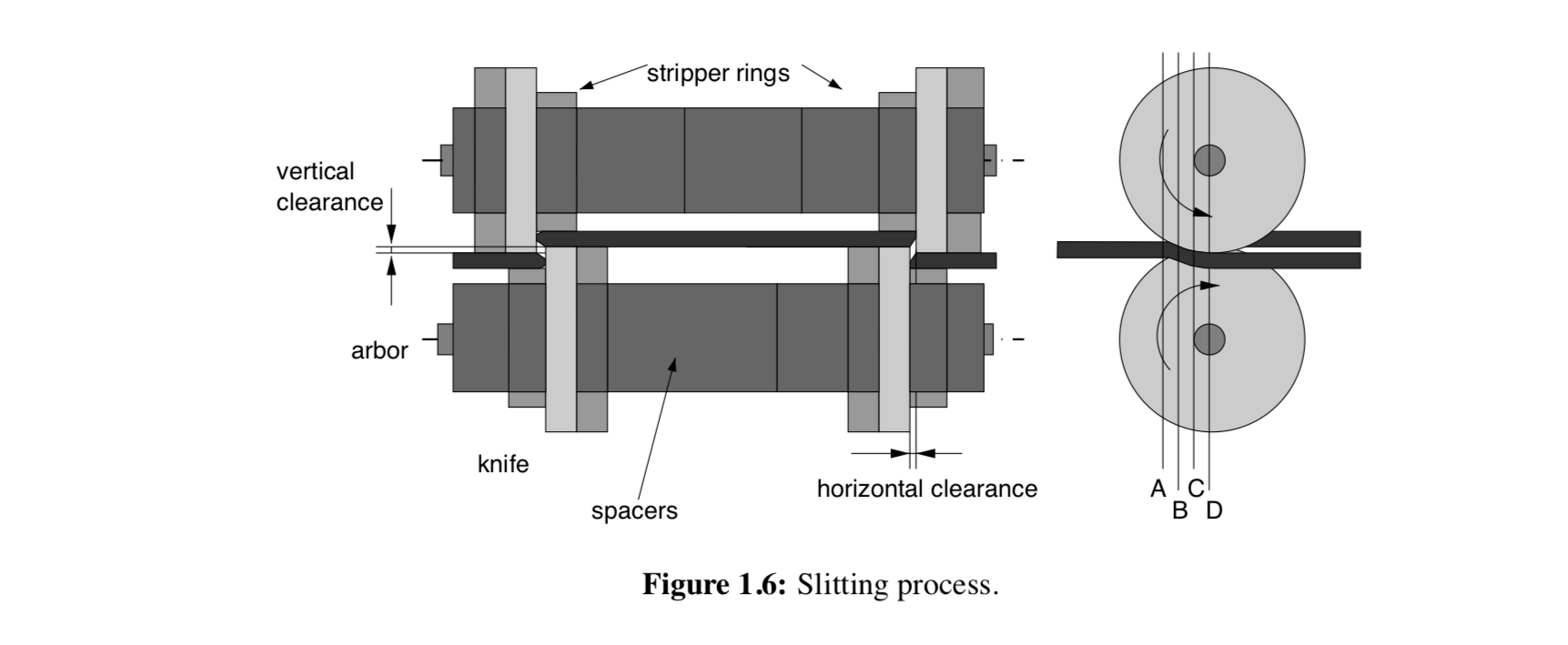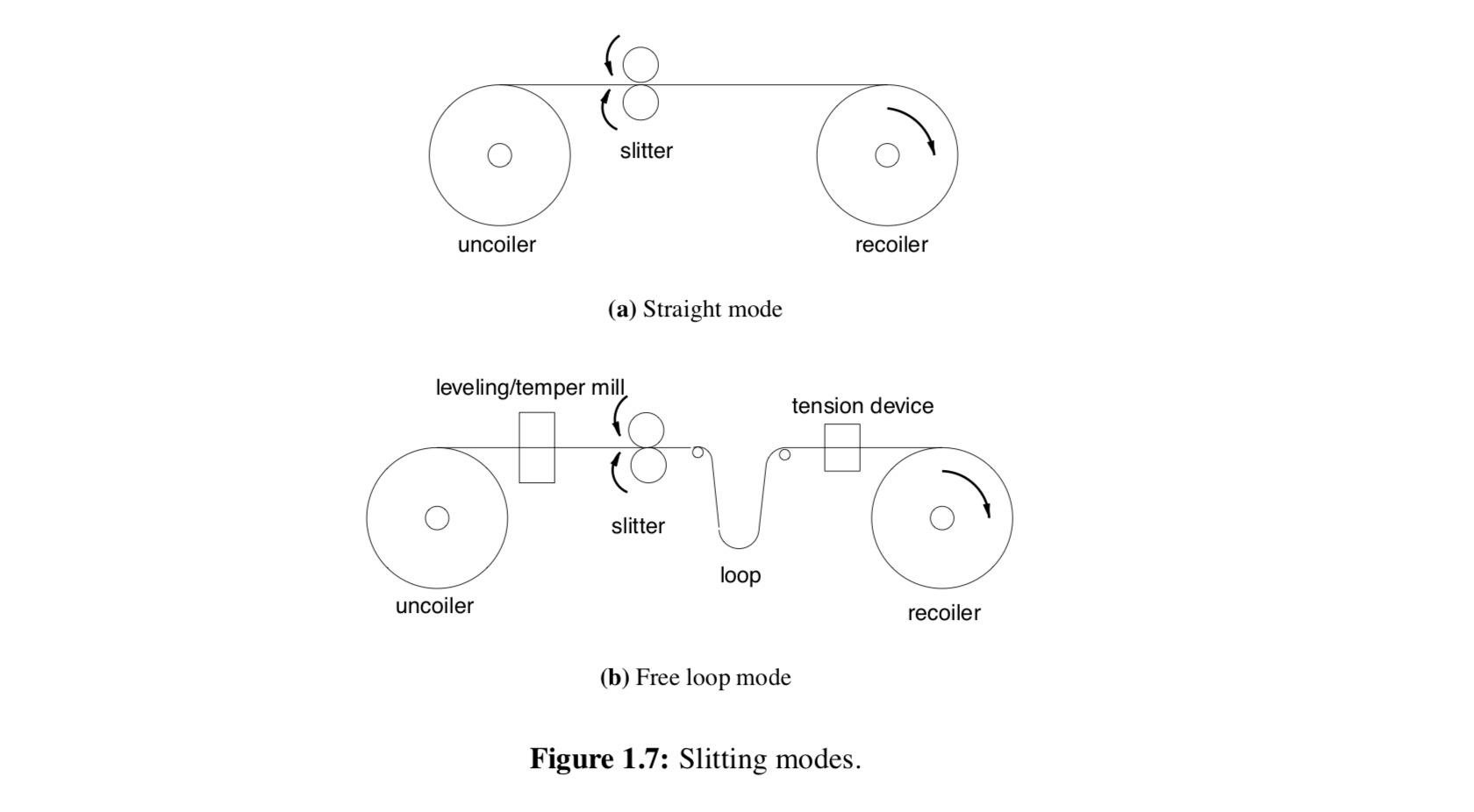Slitting is a sheet metal cutting process with circular knives, which is used to split wide coiled sheet metal into narrower widths or for edge trimming of rolled sheet. The slitting process is schematically shown in Figure 1.6. The slitter knives are mounted on two arbors together with spacers . The spacers determine the width of the cut and the horizontal clear- ance. Sometimes also a vertical clearance (overlap, Appendix A) is used, e.g. to correct for bending of the arbors. Rubber stripper rings are used to eject the strip from between the knives and to support the strip during slitting. Just like guillotining, slitting combines shearing with a bending deformation and the stages A, B, C and D from Figure 1.2 are found next to each other at the same time.

A slitting line consists of an uncoiler, a slitter and a recoiler. The uncoiler, slitter and recoiler are driven by separate motors. Depending on the way the uncoiler, slitter and recoiler are driven, different modes to drive the material through the slitter knives can be distinguished (Madachy 1980). Which mode is chosen depends on the material, the sheet thickness and the number of slits. These modes are depicted in Figure 1.7.
• Straight mode slitting
In this mode the driven recoiler pulls the material from the uncoiler through the slit- ters. It is called pull-through slitting, when the uncoiler and slitter are driven only to feed the material to the recoiler. In driven slitting the slitter is also driven during the process. The motors must now be synchronised to maintain a constant speed of the material as it moves through the line. The advantages of driven slitting are the ability to slit thin sheets and an improved edge quality for all thicknesses.
• Free loop mode slitting
In free loop slitting, the material is allowed to form a free loop between the slitter and the recoiler. A tensioning device in front of the recoiler is needed now, to produce well wound coils. This method makes it possible to process poorly shaped coils.
Shape defects (length variations such as buckles, twists and thickness variation across the width) and internal stresses in the incoming coil influence the result of the slitting process. Therefore, a leveller or a temper mill can be added to the slitting line, to correct defects in the incoming coil, which ensures a better quality of the slitted strips.

As is seen in the previous sections, there are many parameters that influence or can be used to influence the result of the shearing operations. The quality of the cutted sheet depends on the combination of:
Material properties The formability and ductility of the sheet are important aspects in the shearing process;
Incoming material conditions Shape defects and internal stresses in the incoming mate- rial, which are not always known, can have a large influence on the process:
Tool setup The tooling can be adjusted to reach the optimal result for a given material.The most important parameters are the horizontal and vertical clearances, the clamping of the sheet, rake angle or slitter diameter, the cutting speed and the sharpness of the knives. Due to wear, sharp knives will become blunt, leading to poor results, and particularly larger burrs.
The knowledge of the process is mainly empirical and it is not yet fully understood how the aforementioned parameters affect the shearing process. Therefore it is difficult to control the guillotining and in particular the slitting process (Pennington 1998).
In practice the right setup for the knives is mostly found by trial and error combined with experience. This can result in lengthy procedures to find a good setup in case of “new” materials (high strength steels or aluminium) or closer tolerances. Therefore models are needed to shorten the time of trial and error, leading to better quality and higher productivity.
The objective of this project is to build a (finite element) model for stationary shearing processes. With this model it should be possible to investigate the influence of some impor- tant parameters on guillotining and slitting. The results of the model should provide more insight into these process, and hence a better product quality and process control.